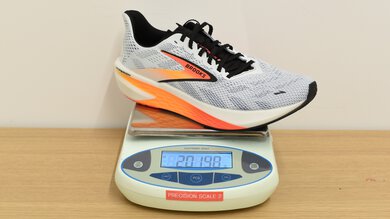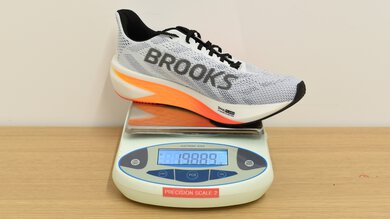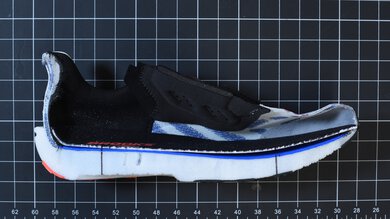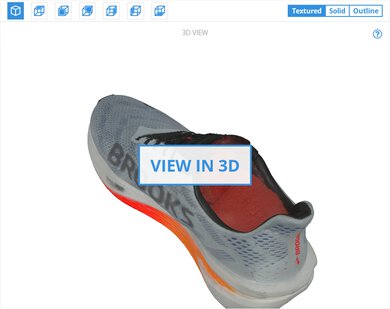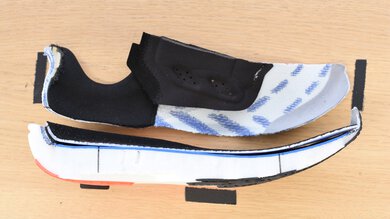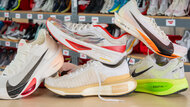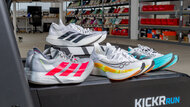An antidote to the trend of high-stack, maximalist shoes, the Brooks Hyperion 2 is a lightweight, low-stack option for daily workouts. If you're looking for the flatter, more grounded feel of traditional running shoes, this is the shoe for you. Though it lacks the high-performance foam of models like the Brooks Hyperion Elite 4 PB that would give it a more energetic ride, the DNA Flash v2 foam returns more energy than many other daily trainers, and with its lightweight build, it can handle some strides.
Our Verdict
The Brooks Hyperion 2 isn't suitable for marathon racing. Even as a daily trainer, it's better suited to shorter runs and up-tempo workouts. It lacks sufficient cushioning and softness for longer distances, and it isn't as responsive as high-performance marathon racers.
-
Impressively lightweight.
-
Poor overall energy return.
-
Overall cushioning is inadequate for longer distances.
-
Not the most stable shoe.
The Brooks Hyperion 2 is a daily trainer rather than a racing flat, but as a trainer, it's most suited to picking up the pace at shorter distances. It doesn't have the greatest energy return, but its remarkably lightweight design and low-stack grounded feel make for a smooth and controlled ride.
-
Impressively lightweight.
-
Poor overall energy return.
The Brooks Hyperion 2 has poor overall energy return. While it's okay for a daily trainer, its foam isn't efficient enough for a very bouncy, responsive ride.
-
Poor overall energy return.
The Brooks Hyperion 2 has mediocre cushioning overall. While it doesn't offer much underfoot protection in the forefoot, its heel does a good job of absorbing impacts at higher intensities.
-
Good heel cushioning at higher forces.
-
Lacks cushioning in the forefoot.
The Brooks Hyperion 2 has decent lateral stability. It's designed to be as lightweight as possible, so there isn't much excess in the outsole, which makes for a smaller platform, especially in the heel. The heel also feels quite soft for heavier runners or at faster paces, which compromises some lateral stability. However, its low stack height and relatively firm foam provide enough stability and ground feel for a pretty controlled ride overall.
-
Low stack height.
-
Firm foam, especially in the forefoot.
-
Narrow outsole in the heel.
-
Heel feels soft at higher forces.
- 5.9 Marathon Racing
- 7.3 5K/10K Racing
Performance Usages
- 5.3 Energy Return
- 5.6 Cushioning
- 7.3 Lateral Stability
Changelog
- Updated Apr 02, 2025: Converted to Test Bench 0.8.
- Updated Apr 02, 2025: Review published.
Check Price
Differences Between Sizes And Variants
We bought and tested the Brooks Hyperion 2 in men's US size 9 in the Illusion/Coral/Black colorway. Here's the label for our pair. You can also buy the shoe in several other colorways, depending on the region and gender, including but not limited to Alloy/Bright White/Black, Black/Ebony/Primer Gray, Crystal Seas/Diva Pink/Black, Cockatoo/Purple/Lavender, and White/Murmur/Sugar Plum.
The shoe only comes in standard widths for men and women.
Compared To Other Running Shoes
The Brooks Hyperion 2 is a lightweight running shoe designed to deliver comfort without added bulk, making it a great alternative for those who don't want to jump on the maximalist trend. Unlike higher-stack trainers like the ASICS NOVABLAST 4, it sits lower to the ground and offers a more streamlined design. This second iteration is a complete overhaul of the original Brooks Hyperion, with a new upper, new outsole, and new foam that add some versatility while keeping down the weight and making it more adept at speed-focused training sessions and intervals.
While most of the market has been tending towards bigger and flashier shoes, the Hyperion lineup is focused on keeping things light and simple. The Brooks Hyperion Max 2 is the higher-stack, more cushioned alternative to the Hyperion 2, with a nylon plate for better stability. Rounding out the lineup is the support-oriented Brooks Hyperion GTS 2 (the GTS stands for "Go-To Support"), which includes GuideRails technology to prevent excessive leg rotation, and the competition-oriented Brooks Hyperion Elite 4, which is intended to be the lineup's high-performance racing model.
For other options, check out the best running shoes we've tested.
Both the Brooks Hyperion 2 and Brooks Hyperion Max 2 are intended for faster-paced workouts, but they approach that goal in different ways. The Hyperion 2 is a more traditional shoe with a lighter weight and lower stack height that makes it well-suited to faster and shorter runs. Meanwhile, the Hyperion Max 2 has a less traditional geometry and falls a bit more into the super trainer category, with a pronounced rocker and nylon plate. It's notably more cushioned than the Hyperion 2, making it the better option for longer efforts.
The Brooks Hyperion 2 and the HOKA Mach 6 are both lightweight trainers adept at picking up the pace. The Brooks is the lighter of the two, making it feel more agile, but the HOKA has better energy return and feels more cushioned underfoot, making it a bit more well-rounded.
The Brooks Hyperion 2 and the New Balance FuelCell Rebel v4 are both relatively lightweight, low-stack daily trainers. They perform very similarly overall, but the New Balance offers better cushioning and more efficient energy return, making it the better-value option for most runners.
The adidas Adizero Evo SL is better overall than the Brooks Hyperion 2, offering more versatility for different kinds of runs. It delivers significantly better energy return, making for a more responsive ride when picking up the pace, and its more cushioned midsole makes it a better fit for longer efforts as well.
The New Balance FuelCell Rebel v5 and the Brooks Hyperion 2 represent two different philosophies within the daily trainer space. The Rebel, once seen as a lightweight performance trainer, has shifted toward a softer, higher-stacked daily trainer with broader appeal—more cushioned, more comfortable, but less exciting than previous versions. In contrast, the Hyperion 2 sticks to the roots of the lightweight, lower-stack, more traditional trainer niche. It's way lighter, firmer, and tuned for runners who value ground feel and precision over plushness. The Rebel v5 is noticeably softer underfoot, with more give and a more relaxed, forgiving ride.
Test Results
Note: In order for our 3D scanner to detect the nitrogen-infused foam on this model, we had to use scanning spray, which appears as white residue on the 3D model. This doesn't reflect the shoe's color or texture in a completely accurate way.
The heel doesn't have the highest energy return. The shoe isn't really suited to longer distances, where efficiency is key.
The forefoot offers a bit more energy return than the heel, making for somewhat springy toe-offs, but you won't have the same propulsive feel as a modern-day racing flat like the Nike Vaporfly 3.
The shoe's heel is reasonably cushioned. It doesn't offer much protection underfoot at low to moderate forces, but it absorbs a greater amount of energy at high forces, making it especially well-suited to faster paces.
The cushioning in the forefoot is sub-par. It's notably firmer in the forefoot than the heel, so it's much less forgiving and protected for mid and forefoot strikers. That said, if you prefer a shoe with more ground feel, the cushioning may be sufficient.
The heel is very firm at low forces, adding stability for mid and forefoot runners or lighter heel strikers. At higher forces, it's less firm than models like the New Balance FuelCell Rebel v4, making for a softer, albeit somewhat less stable, feel underfoot for heavier heel strikers or when picking up the pace.
By contrast, the forefoot is incredibly firm, so it's very stable and controlled for forefoot strikers at all intensities. However, it's likely too firm for those who prefer a softer feel underfoot.
Check Price
Comments
Brooks Hyperion 2: Main Discussion
Let us know why you want us to review the product here, or encourage others to vote for this product.


